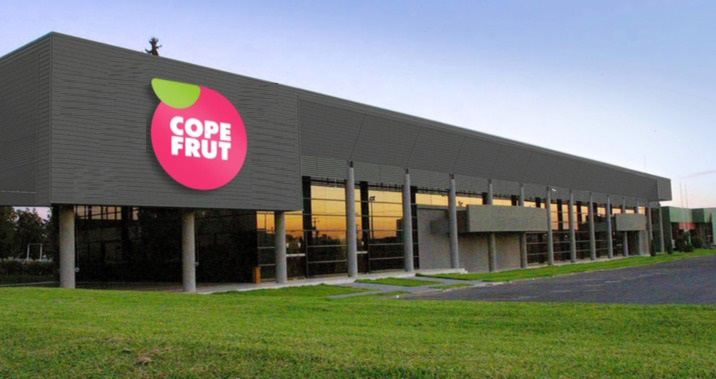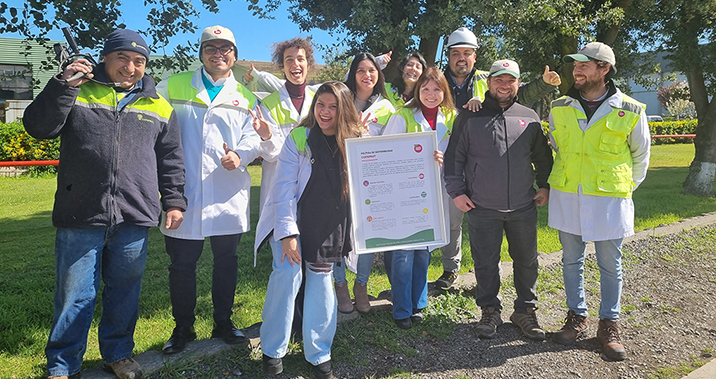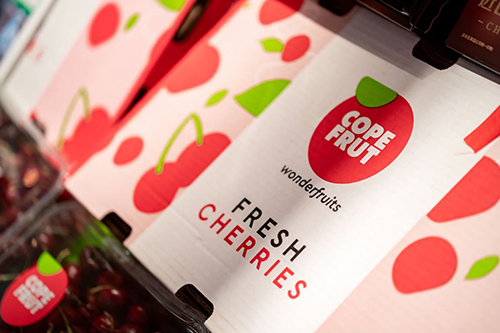With the current state of the planet, it is critical to take steps toward mitigating climate change and work to obtain carbon neutrality. Chilean company, Copefrut, is blazing the sustainability trail as a model exemplar of what climate action leadership should look like.
Founded in 1955, Copefrut S.A (Cooperativa Agricola y Fruticola de Curico Ltda.) began as a farmers’ cooperative in the South Central area of Chile and with the spirit of collaboration, trust and professionalism, the company has expanded as one of the largest Chilean year-round producers and exporters of fresh fruit as well as frozen fruits and fruit juices. It is the second largest exporter of cherries (22 million kg per year) in the southern hemisphere and also exports by volume, 46 million kg. of red and green apples each year in addition to 1.5 million kg. of blueberries, 7 million kg. of plums and 9 million kg. of kiwis—the latter of which was first introduced to Chile by Copefrut.
UN Goals:
6 Water and sanitation
7 Agriculture and clean energy
9 Industry, innovation and infrastructure
12 Responsible consumption and production
13 Climate action
The company is headquartered in Romeral, Chile, with another office in Santiago, in addition to operation and refrigeration facilities in China. With over 300 producers (located in four areas between the south of the Metropolitan Region and the Maule Region) who work with Copefrut advisors and technicians, the company specializes in quality and safety to deliver an experience that improves the lives of people while also caring for the planet. The company exports to all corners of the globe, including Europe, the U.S., Latin America and Asia and attributes its success to these long-term relationships, operational excellence and strong commercial performance as well as its company-wide commitment to add value.
Part of that value is Copefrut’s sustainability commitment in six action pillars:
- Corporate Governance – Corporate sustainability governance
- Growers – Sustainable farming
- Communities – Creating value alongside communities
- Environment – Efficient and low-carbon model
- Employees – Concern for people
- Customers – Quality, innovation and permanent trust
Among its many awards and recognition, Copefrut was recognized in September of 2022 as Supplier of the Year by Pagoda, one of the company’s main international customers. It was awarded first place in 2018 from Principal financial group Chile for its commitment and concern for its collaborators’ financial future and, in 2016, the prize from Principal financial group Chile for the Best Company for Employee Financial Future. In 2010, 2013, 2014, 2015 and 2016 Copefrut received the prize for Innovation from the Chile Unido Foundation.


The challenge: Greenhouse gas and climate change
Carbon footprint is a term used to estimate the volume of greenhouse gasses (GHGs; e.g., carbon dioxide [CO2] methane [CH4], nitrous oxide [N2O], hydrofluorocarbons [HFCs], etc.) being emitted into the atmosphere.
According to the EPA, in the U.S., carbon dioxide emissions are the largest contributor of GHGs (79.4%) and are generated via burning fossil fuels (e.g., on-farm processes, transportation, etc.), soil tillage, et al. Methane is the second largest percentage (11.5%) of greenhouse gas emissions (GHGEs) and is more than 28 times as potent as carbon dioxide at trapping atmospheric heat. Methane is emitted during the production and transport of coal, natural gas and oil as well as decomposition of organic agro-industrial components, in addition to other sources. Nitrous oxide is the third largest emitter (6.2%) during agricultural land use from cropped and grazed soils, fertilizers used for crop production, et al. Last, hydrofluorocarbons are the lowest emitters (3%) and are released through air conditioning and refrigeration, etc. but are no less destructive—for a given amount of mass, they trap considerably more heat in the atmosphere than CO2.
It goes without saying that we need food to survive, and that food needs to be grown, harvested, processed, stored/refrigerated, transported and distributed. Overall, it was estimated that in 2021, agriculture was responsible for 10.6 percent (671.5 million metric tons of carbon dioxide equivalent [MMT CO2 eq.]) of U.S. GHGEs. Electricity-related CO2 emissions accounted for 0.6 of that percentage. This does not take into account transportation, commercial or industrial percentages, 28.5 % (1,809.5 MMT CO2 eq.), 15.3% (972.2 MMT CO2 eq.) and 30.1 % (1,909.2 MMT CO2 eq.) respectively, that could include, in part, a percentage of agri-business.
The release of these gases traps atmospheric heat, and the concentration of the gases is a major contributor to climate change. Since the pre-industrial period of the 1950s it is estimated that the earth’s global average temperature has increased by approximately 1.1 degree Celsius (1.9 degrees Fahrenheit) and continues to increase by more than 0.2 degrees Celsius (0.36 degrees Fahrenheit) per decade—and not without consequences.
 Even in the last decade, these consequences have become more evident through widespread shifts in weather systems, resulting in record-breaking heat waves in the U.S. and Europe, disastrous flooding in Pakistan and China, severe drought in Africa and, in the North and South poles, record quantities of ice melt. In California, the annual area burned by wildfires increased 500 percent between 1972 and 2018—fires that are more frequent, spread faster and burn longer.
Even in the last decade, these consequences have become more evident through widespread shifts in weather systems, resulting in record-breaking heat waves in the U.S. and Europe, disastrous flooding in Pakistan and China, severe drought in Africa and, in the North and South poles, record quantities of ice melt. In California, the annual area burned by wildfires increased 500 percent between 1972 and 2018—fires that are more frequent, spread faster and burn longer.
Rising global temperatures can result in the disruption of valuable ecosystems, diminished supplies of drinking water, withering crops and an increased positive feedback loop in which drier soil and less plant cover cause even faster water evaporation. What might seem a slight shift in temperature can cause dramatic changes that flow down through food webs and the environment, adversely impacting agricultural productivity on local and regional scales. Changes in rainfall patterns, more frequent climate extremes (i.e., high temperatures or drought), altered patterns of pest pressure and changes in seasonal and diurnal temperature patterns are real and proximal threats to life on the planet.
According to the USDA, “These impacts will affect national and international markets; the prices of food, fiber, and energy; agricultural incomes; and the environment. How farmers respond or adapt…will ultimately determine the impact of these altered growing conditions on production, natural resources, and food security.”
The solution: Measuring and mitigating carbon emissions
As the saying goes, “Responsibility is accepting that you are the cause and the solution of the matter.”
Copefrut takes to heart the gravity of climate change and its adverse effects on agricultural development, the environment, valuable ecosystems and, as well, its responsibility to take positive action to mitigate its carbon footprint. It is essential to begin to understand where carbon dioxide and other GHGEs come from, so that action can be taken to reduce those emissions. As concerns grow and the environmental impacts of climate change worsen, Copefrut has committed to a comprehensive sustainability plan with the goal to accelerate the reduction of emissions it generates.
For its 2021 – 2022 season, the company implemented an Energy Management System (EMS) in its plants, based on the ISO 50,001 standard, which was designed to reduce energy consumption per ton of fruit processed. This commitment would map out its ever-expanding sustainability policy and require involvement at all levels. Copefrut designed an energy policy that included its objectives and carbon neutral certification goals as well as an action plan. To ensure optimum adherence and execution, the company created an Energy Management Committee to review each month’s energy indicators, which provided a comprehensive framework for ongoing guidance on the lowest and highest points of energy use.
“The policy is defining our vision for sustainability and how we’re impacting both the environment and our communities. We’re very proud to have this program in place, it’s a very big step for us and it’s one that involves the whole company taking little steps all the time towards that commitment,” states Carolina Prado, Innovation and Sustainability Manager at Copefrut.
In 2021, guided by its goal of 100% carbon neutrality, the company partnered with Enel Generacion, committing to a four-year energy contract. The contract ensures that the entire supply provided from the National Electricity System used in Copefrut’s production processes comes from for 100% clean and renewable energy sources. This provided an opportunity to change the energy matrix of its three operational plants, contributing to a reduction of GHG concentrations with benefits such as energy traceability, origin and ownership certification and environmental and social implications—all of which contribute to effective sustainability management.
The agreement considered the supply of energy generated from renewable sources, such as wind, solar, geothermal and hydro power as well as obtaining the Green Seal issued by the International Renewable Energy Certificates (I-REC), an independent international certifying entity on renewable energy use. The Green Seal is a unique type of certification, the purpose of which is to certify that the annual electric power consumed by a company has been introduced into the electric power system by renewable sources of electric power generation, aligning with the company’s goal of carbon neutrality.
 Copefrut also began measuring emissions produced by transport of its organic apples to international markets (i.e., Europe and the U.S.). This allowed the company to calculate and offset the emissions through the purchase of carbon credits to support its varied initiatives (e.g., a wind power project in the Biobío region of Chile, the REDD+ project in the Amazon rainforest in Acre Brazil to mitigate deforestation, conservation of the Valdivian Coastal Reserve).
Copefrut also began measuring emissions produced by transport of its organic apples to international markets (i.e., Europe and the U.S.). This allowed the company to calculate and offset the emissions through the purchase of carbon credits to support its varied initiatives (e.g., a wind power project in the Biobío region of Chile, the REDD+ project in the Amazon rainforest in Acre Brazil to mitigate deforestation, conservation of the Valdivian Coastal Reserve).
There are five steps to CarbonNeutral® certification:
- Define – Understand what should be covered in your footprint
- Measure – Calculate your footprint accurately and conservatively
- Target – Set goals to reduce the footprint and offset all remaining emissions
- Reduce – Deliver internal reductions and offset all remaining emissions through financing verified emissions reductions and removals
- Communicate – Demonstrate your climate action and engage teams, customers and stakeholders
Each step contains a subgroup of protocols and requirements that must be fulfilled for certification. Through a two-year process of completing these steps and protocols, Copefrut was able to offset emissions produced from land and sea transportation, earning the company the CarbonNeutral® Delivery certification from Climate Impact Partners (a private environmental solutions organization) and also affirmed that its organic apples had an equal or lesser environmental impact than those produced on a local level.
In its 2022 annual report, Copefrut stated that it had started calculating and offsetting the carbon footprint for all the processes in its organic apple facilities, including procuring raw materials, production in the fields, packaging and storage for minimal impact on the climate. This earned the company the CarbonNeutral® Product certification from Climate Impact Partner, making its organic apple the first product to become carbon neutral certified in South America under the CarbonNeutral® standard. Copefrut also plans to extend these processes to other commodities over time to further broaden its sustainability scope.
In addition to Copefrut’s internal efforts to mitigate the direct emissions of its facilities, the company supports its growers in transitioning to more sustainable practices in the field to minimize indirect emissions. To inform its growers, Copefrut collected data on consumption and equipment classification in the fields, then issued a report that advised on objective recommendations and technical specifications and educated growers on the importance of sustainable action. The report provided steps to initiate an effective plan to implement nonconventional renewable energies in the field.
Copefrut’s first sustainability report (2022) included data around the company’s environmental performance since the implementation of its new corporate sustainability policy. This provided not only a baseline measurement of its sustainability efforts but added a component of transparency from the company as well.
The takeaway: Measurable results on emissions reduction
The agricultural sector has a significant global emissions impact and Copefrut, through its carbon neutrality goals, has been instrumental to its mitigation of greenhouse gas emissions (GHGEs) from the cradle-to-door cycle by measuring and neutralizing its total gross emissions generated from operations.
During the 2021-2022 period Copefrut reduced its total operational energy consumption by 7.14%. As a result, the company reduced its consumption from 23,081,964 kWh in 2020-2021 to 21,460,574 kWh in 2021-2022 and reduced its energy consumption (in kWh) per kilogram produced by 18.58%.
In addition, according to its 2022 annual report, Copefrut offset the emissions of 987 metric tons of CO2 equivalent (tCO2e), corresponding to the transport and delivery of organic apples. This is equivalent to driving 4 million kilometers in a gasoline-powered vehicle. In 2023, the company offset emissions equivalent to the charge of almost 200 million cell phones or the electricity consumed by over 300 homes in a year. In addition, the company aims to cover close to 25% of its total energy use with renewable energy within the next three years.
 Copefrut’s other energy-saving initiatives include replacing old, energy-consuming machinery with newer, more efficient versions (e.g., refrigeration equipment low in GWP—an indicator that measures the amount of heat that can be trapped by a given greenhouse gas) and small things that make a big difference such as ensuring refrigerator doors are closed and sealed and that lights are off in unoccupied areas, resulting in lower energy costs.
Copefrut’s other energy-saving initiatives include replacing old, energy-consuming machinery with newer, more efficient versions (e.g., refrigeration equipment low in GWP—an indicator that measures the amount of heat that can be trapped by a given greenhouse gas) and small things that make a big difference such as ensuring refrigerator doors are closed and sealed and that lights are off in unoccupied areas, resulting in lower energy costs.
And Copefrut’s work doesn’t stop there. The company understands the need for overarching sustainability goals and has many working initiatives including, but not limited to, waste management (where the company worked hand in hand with ReSimple, the first large-scale collective management system (GRANSIC), formed to comply with the REP Law for containers and packaging), packaging innovations (maximizing the recyclability of its packaging, replacing traditional packaging with more sustainable and eco-friendly alternatives), local community development (social and economic development of local communities by actively contributing to the generation of employment) and social responsibility (safeguarding and promoting respect for universal human rights, both in the scope of its operations and those of its suppliers). In addition, for its water management initiative, the company installed flowmeters on its wells to collect data statistics on water consumption as well as measuring its growers’ water footprint.
Copefrut’s dedication to sustainability is evident through its sustainability policy and numerous initiatives. They are putting in the work to provide healthy food while protecting life on the planet. According to Copefrut, “Sustainability is no longer an option, but an issue that we must develop for the benefit of our clients, our collaborators and the planet.”
